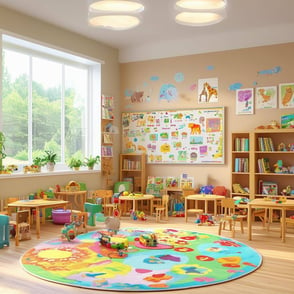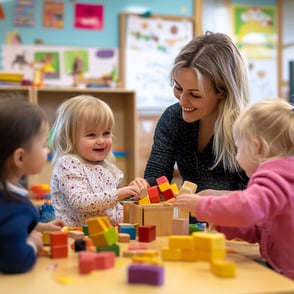Exploring the HighScope Approach to Early Years Education
The HighScope approach to early years education is a well-established, research-based method that emphasises active learning and child-initiated experiences. Developed in the 1960s by David Weikart and his colleagues, HighScope was designed to provide children with a structured yet flexible learning environment that fosters independence, critical thinking, and social skills. This blog post will explore the specifics of the HighScope approach, its developmental frameworks, pedagogic principles, and notable schools in the UK that implement this model. Additionally, we will compare and contrast HighScope with other early years specialisms, including Reggio Emilia, Rudolf Steiner, Te Whāriki, Forest School, and Montessori.
History and Origins of HighScope
The HighScope approach originated from the Perry Preschool Project, which aimed to improve educational outcomes for children from low-income families. The project demonstrated that children who participated in HighScope's active learning curriculum showed significant gains in academic and social skills. Since then, HighScope has evolved into a comprehensive educational framework that is now used in various early childhood settings worldwide.
Core Areas of Learning and Developmental Frameworks
HighScope is built around a well-defined framework that focuses on key developmental areas. The curriculum is organised into several key experiences that promote holistic development:
- Active Learning: Children learn best through hands-on experiences. HighScope encourages exploration, experimentation, and problem-solving.
- Plan-Do-Review Sequence: This unique structure allows children to plan their activities, engage in them, and then reflect on their experiences, fostering critical thinking and self-assessment.

- Social Interaction: HighScope emphasises collaborative play and group activities, helping children develop social skills and emotional intelligence.
- Language and Literacy Development: The approach integrates language-rich experiences, promoting vocabulary development and communication skills.
- Mathematics and Science: Children engage in activities that promote mathematical thinking and scientific inquiry through exploration and discovery.
Principle Pedagogic Principles
HighScope is guided by several key pedagogic principles that shape its teaching and learning practices:
- Child-Centered Learning: The approach prioritises the interests and needs of the child, allowing them to take an active role in their learning.
- Adult-Child Interaction: Educators act as facilitators, guiding children through their learning experiences while encouraging independence and exploration.
- Assessment and Documentation: Ongoing assessment and documentation of children's progress are integral to the HighScope approach, helping educators tailor their teaching to individual needs.
- Community and Family Involvement: HighScope recognises the importance of family and community in a child's education, fostering partnerships that support learning.
Notable HighScope Schools in the UK
HighScope has gained traction in the UK, with several schools implementing its principles effectively. Some notable institutions include:
Hatching Dragons City - our school in the heart of the City of London was our first. Set up in 2015 in the Welsh Chapel of Jewin on Fann Street, the school relocated to the Ironmongers Hall to expand its provision to meet the growing demand for its Plan>Do>Review approach to structured learning. The day is broken into 4 distinct sessional blocks, each with its own circle time to initiate activities, during which teachers remind children of the values and behaviours we're focussing on, and what thematic focus we'll be looking into for the day and session. It invites the children to plan their activities themselves, working together to think about what projects they want to pursue, with the teachers in support to further their learning. And at the end, we review and talk about what we've learnt, so that we can progress things in subsequent sessions. Book your visit today!
- HighScope UK: This organisation provides training and resources for educators and operates several settings that embody the HighScope philosophy.
- Little Explorers Nursery: Located in London, this nursery integrates HighScope principles into its curriculum, focusing on active learning and child-led experiences.
- Bright Horizons Nurseries: With multiple locations across the UK, Bright Horizons incorporates HighScope practices to create engaging and supportive learning environments.
Comparing HighScope with Other Early Years Specialisms
When considering early childhood education, it's essential to compare HighScope with other methodologies. Here’s how it stands against some well-known approaches:
Reggio Emilia
Both HighScope and Reggio Emilia emphasize active learning and child agency. However, Reggio Emilia focuses more on project-based learning and the role of the environment as a teacher, while HighScope employs a structured plan-do-review process to guide learning. To find out more about the Reggio method, read our blog
Rudolf Steiner (Waldorf Education)
Waldorf education emphasises holistic development and creativity, often incorporating artistic activities. In contrast, HighScope is more structured and emphasises active learning through a systematic approach that includes planning, doing, and reviewing. To find out more about the Steiner approach, read our blog
Te Whāriki
Te Whāriki, the early childhood curriculum of New Zealand, shares HighScope's commitment to child-centered learning and family involvement. However, Te Whāriki is deeply rooted in the cultural context of New Zealand, incorporating Māori perspectives and values, which adds a unique cultural dimension to its framework. HighScope, while adaptable, maintains a more universal approach to its curriculum design. To find out more about the Te Whariki approach read our blog
Forest School
Forest School prioritises outdoor learning and environmental education, encouraging children to engage with nature. While HighScope also values experiential learning, it is more structured in its approach, focusing on a balance of indoor and outdoor activities that align with its developmental goals. To find out more about the Forest School approach in early years education, read our blog
Montessori
Montessori education, like HighScope, supports child-led learning and independence. However, Montessori is characterized by its use of specific learning materials and a prepared environment, whereas HighScope emphasizes flexibility and adaptability in its resources and settings, allowing for a broader range of child-initiated activities. To find out more about the Montessori approach to early years education, read our blog
Focus Areas of HighScope’s Curriculum
HighScope's curriculum is comprehensive, covering a broad range of areas essential for a child’s development. Some of the key areas emphasized in HighScope classrooms include:
1. Language and Literacy
Language development is a priority in the HighScope approach.
Educators create language-rich environments where children are encouraged to communicate, express themselves, and develop vocabulary. The curriculum fosters the love of reading, writing, and storytelling, with a focus on building foundational literacy skills. Through dialogue with peers and teachers, children develop their ability to comprehend, formulate, and articulate thoughts.
2. Mathematics and Science
HighScope places a strong emphasis on early mathematics and science.
The curriculum is designed to introduce children to the concepts of numbers, measurement, and patterns, using engaging hands-on activities like counting objects, sorting items by size or color, and experimenting with different materials to observe how they react to various stimuli. Science exploration is driven by curiosity and discovery, allowing children to investigate the world around them and develop critical thinking skills.
3. Social and Emotional Development
One of the core strengths of HighScope is its emphasis on social skills and emotional intelligence. Group activities, peer interactions, and collaborative play are central to the curriculum, allowing children to build relationships, practice empathy, and learn about teamwork. Educators help children navigate their emotions and understand the feelings of others, creating a positive environment for social development.
4. Creative Arts and Imagination
Creative play is a vital component of the HighScope approach. Whether through drawing, music, or imaginative role-play, children are encouraged to express themselves creatively.
This fosters both cognitive development and emotional expression, helping children explore their identities and understand the world in new ways.
5. Physical Development
HighScope promotes physical activity through both structured and unstructured play. Children engage in activities that develop fine and gross motor skills, such as building with blocks, climbing, running, and dancing. Physical development is integral to overall learning, contributing to better focus, emotional regulation, and social interaction.
Educator’s Role in HighScope
HighScope is distinct in its view of the educator's role.
Teachers are not just instructors; they are facilitators of learning. Instead of directly imparting knowledge, educators guide children through their experiences, providing the support and tools necessary to help them explore their world.
Teachers observe, interact, and document children’s progress, allowing them to tailor their approach to meet individual needs. This responsive teaching style fosters a sense of autonomy in children while ensuring they have the guidance to succeed.
HighScope in Practice: Notable Institutions
In the UK, several schools and early learning centres have embraced the HighScope method.
One example is Hatching Dragons City, a well-known nursery that adopted the HighScope model in the heart of London. Since its opening in 2015, Hatching Dragons City has seen great success, emphasising the Plan-Do-Review process.
Children at this school are encouraged to plan their activities at the start of the day, engage in them, and reflect on their experiences during structured circle times. This method has become a key feature of their learning environment, and the school has expanded to meet growing demand.
Other notable institutions include HighScope UK, which offers training to educators and operates settings using HighScope principles, and Little Explorers Nursery, which integrates HighScope’s child-centred curriculum to create an active and engaging learning environment.
Bright Horizons Nurseries, another example, employs HighScope practices to promote development in key learning areas while fostering a nurturing environment.
The Future of HighScope in Early Years Education
As the landscape of early childhood education continues to evolve, the HighScope approach remains a dynamic and supportive framework that adapts to the needs of diverse learners. Its emphasis on active learning, critical thinking, and social development aligns with the growing recognition of these skills as essential for future success. By fostering an inclusive and compassionate learning environment, HighScope prepares children to navigate and contribute positively to an increasingly interconnected world.
In conclusion, the HighScope approach offers a comprehensive and innovative model for early years education, one that is both supportive and empowering for children, educators, and families alike. As more schools and nurseries adopt its principles, the potential for nurturing well-rounded, confident, and capable individuals continues to expand, promising a brighter future for the next generation.
FAQs about the HighScope Approach
What is the main focus of the HighScope approach?The main focus of HighScope is active learning, where children take an active role in planning, doing, and reviewing their learning experiences. The approach encourages hands-on activities that promote critical thinking, independence, and social development.
How is the HighScope curriculum structured?
The HighScope curriculum is structured around the Plan-Do-Review sequence, where children plan their activities, engage in them, and then reflect on what they have learned.
The curriculum covers key areas such as language, mathematics, science, social-emotional development, and physical skills.
What is the role of educators in the HighScope approach?
Educators act as facilitators, guiding children through their learning experiences.
They observe, document progress, and provide the necessary support to help children achieve their learning goals. Teachers encourage independence, reflection, and critical thinking.
What makes HighScope different from Montessori?
While both HighScope and Montessori emphasise child-centred learning, Montessori uses specific learning materials and a carefully prepared environment, whereas HighScope offers more flexibility in the resources used and focuses on a structured Plan-Do-Review process.
Subscribe here!

31-Dec-2024 18:41:44
Related Articles





Write a Comment